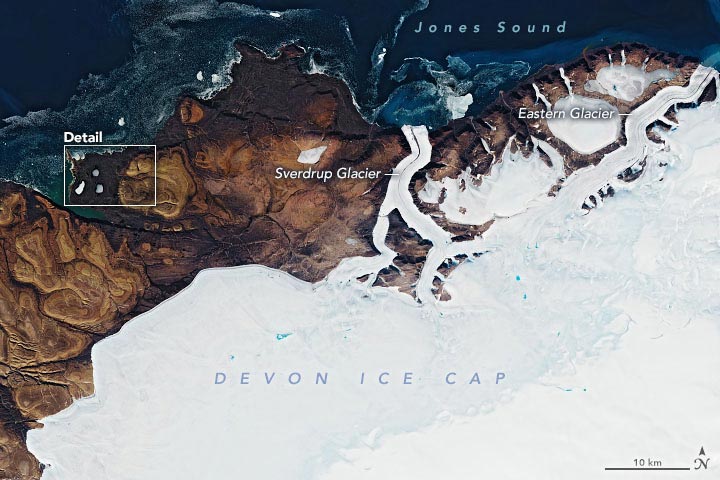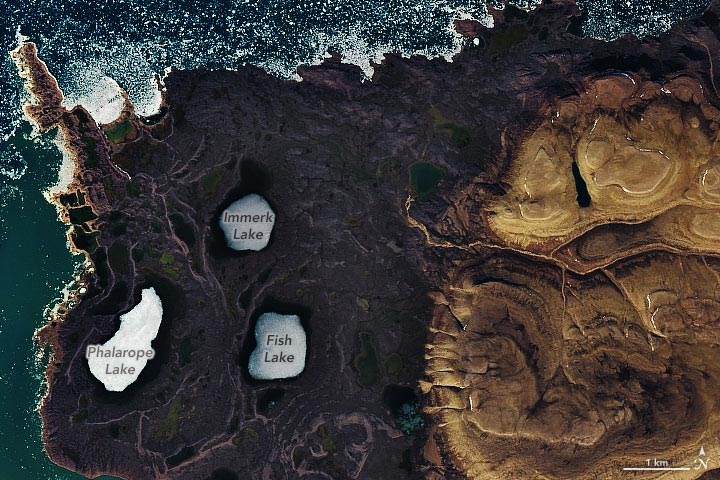Because the atmosphere is about 100 times thinner and less dense than on Earth, weather on Mars is defined by its extremes.
Near the equator, daytime highs regularly exceed the freezing point, occasionally rising above 15 degrees Celsius on summer days (into the 60s in Fahrenheit). But even during the hottest part of summer, nighttime temperatures regularly plummet below -75 °C (-100°F) because of how little heat the atmosphere can retain. Near the poles, the cold is even more punishing, with wintertime lows that drop below -120°C (-184°F).
Nonetheless, Eric Vaz thinks that someday certain hardy plants from Earth could be grown on Mars. “In fact, I think we will need to bring plants and think about terraforming if we are serious about having people live on Mars,” said Vaz, a professor of geographical analysis at Ryerson University. Plants could play a role in life-support systems because they recycle water and oxygen while filtering out carbon dioxide. Vaz recently co-authored a study, published in Life Sciences in Space Research, that lays out a new framework for small-scale terraforming on Mars.
The Martian atmosphere is 95 percent carbon dioxide, with just trace amounts of oxygen and water vapor. Since terraforming Mars on a global scale would be extremely difficult with current technology, Vaz instead envisions a future in which terraforming would happen in small enclosed areas.
Vaz and one of his graduate students used 30 years of global weather data from WorldClim 2 and elevation data from the U.S. Geological Survey to identify and analyze the places on Earth with conditions most similar to those found on Mars. Using geographic information system (GIS) tools to analyze global temperature, precipitation, elevation, and solar radiation data, they identified certain areas in the Canadian Arctic and Antarctica that have conditions more similar to Mars than any other places on Earth. Parts of Canada’s Devon Island, for instance, have temperatures that often exceed 10°C (50 °F) in the summer, yet drop as low as -50 °C (-58 °F) in the winter.
After sorting through an extensive database of plant species from the Global Biodiversity Information Facility, Vaz honed in on certain plants that he thinks people might want to eventually bring to Mars. Among the most promising were in the Bryophyte phyla—small plants like mosses, liverworts, and hornworts—and the Tracheophyta phyla—vascular plants such as ferns and horsetail. The most promising candidate proved to be the genus Poa, a group of perennial grasses with hundreds of different species. In addition to being able to handle frigid temperatures and intense solar radiation, Poa would take up minimal space, require little maintenance, and could produce large quantities of seeds, explained Vaz.
The natural-color satellite image above shows the Truelove Lowlands—one of the areas on Devon Island that has conditions similar to those on Mars. It is also an especially lush part of the island and home to Poa arctica (arctic bluegrass) and Poa abbreviata (short bluegrass) . Unlike the Devon Ice Cap to the east, these lowlands are known for a having a milder and more hospitable microclimate than other parts of the island because nearby cliffs help regulate the temperature. In addition to the plants that carpet the surface in the summer, Truelove Lowlands attracts populations of muskoxen, foxes, and polar bears. The image was acquired by the Operational Land Imager (OLI) on Landsat 8 in July 2020.
Vaz cautions that he does not expect to see arctic bluegrass growing on Mars anytime soon, but he is optimistic about the future, given NASA’s long-term plans to send astronauts to Mars and a series of satellites and rovers to the Red Planet.
“Looking outside of Earth opens up the idea that we must be a species going to different places to survive. We are travelers. We need to think outside of our confinement,” Vaz said. “There are enormous technological challenges that will have to be addressed before bluegrass or any other plants will be grown on Mars, but the good news is that we already have incredible geospatial tools and databases of environmental data that we can start using today to start working on the problem.”
Reference: “Mars Terraforming: A Geographic Information Systems Framework” by Eric Vaz and Elissa Penfound, 26 December 2019, Life Sciences in Space Research.
DOI: 10.1016/j.lssr.2019.12.001
NASA Earth Observatory images by Joshua Stevens, using Landsat data from the U.S. Geological Survey.











It is good research, but Mars will forever remain just like it is today. As fast as we could create any atmosphere, the solar wind would strip it away, due to the lack of a magnetic field on Mars. Sorry, but Mars isn’t a fixer up planet. The only thing Mars will ever be good for, is a place to search for life off the Earth. Find any evidence of life there, and it is certainly present throughout the universe. Any puny human effort to change Mars could never stay ahead of the Sun’s power to negate anything we could do.
Living on Mars would be like volunteering to live in an abandoned salt mine, or living on Antarctica year round, for the rest of your life. Why would you want to do that? See a lot of people moving to Antarctica, Greenland, or Alaska? And they have air and water.
Demographic experts project that the population of Earth will begin to decline by the second half of this century. So there is no need to plan to flee anywhere. Earth has a lot of natural resources left in the crust. Except for the fossil fuels, most of what we need will last for thousands of years. Metals and other elements will get more expensive, but fewer and fewer people will need less and less of them, as the decades pass. And a lot of things we now throw away can be recycled after the highest quality ores run out. Eventually, our biggest problem will be not having enough people around to maintain the needed pool of special talents to keep the industrial civilization functioning. That would be a bigger problem on resource poor Mars, than it might become on Earth.
So despite what you might see on Facebook, or watch on some YouTube video, Earth is kind of it for us. We are probably safe here until the Sun finally cooks the Earth. I wouldn’t worry about what will happen 500,000,000, to a billion years in the future.
And space is filled with dangerous radiation being emitted by the limitless number of stars out there. The look pretty from light years away, but the vast majority of them are dangerously unstable. And every single one of them can damage your DNA with the radiation they emit. It’s rough out there in space, so take care of here.
In order for life to exist on Mars, the core needs to be heated to create a magnetic field. Carbon needs to be released into the atmosphere to heat the planet. The melting of the polar ice caps will create oceans, and other water ways. We’ll be long dead, but in 100 years, Mars will have life.
The idea that Mars can be regarded as a second home is certainly persuasive. Mars has gravity that Earth’s evolved life forms can withstand. Mars does not have a runaway green house atmosphere like Venus. Mar’s atmosphere, though scarce, is relatively inert. The planet is our next door neighbor. However, perhaps Mars should not be terraformed. It can be agued that it would be a waste of resources, and the results will not be anything like what we have on Earth. More than likely we will probably simply achieve a polluted, bio contaminated planet, on Mars. O’Neill cylinders may be the better option. However, the technology for O’Neill cylinders has a long way to go, and we would probably be waiting 500 years or so, unless there is some other imperative that drives us. As they say, necessity is the mother of all invention.
Yet until then, we have all our eggs in one basket, here on Earth. The likelihood of an extinction level event from asteroid bombardment is pretty much guaranteed. But no one has a crystal ball to guess when this will occur. Will it be tomorrow, or in a billion years? We have already created a seed bank here on Earth, that acts as ‘insurance policy’ for such similar disasters, but this earth-bound seed bank can also be jeopardized. Perhaps Mars should instead be viewed as being the second ‘back-up’ repository. This concept is well understood in the IT world, where you take an ‘offline back-up’ and store the data off site. The data stored off site is usually simply stored in a fire resistant, climate controlled environment, but usually the off site back-up facility is not a fully functioning data center. Now when considering Mars, the planet may not be an adequate location to propagate life as we know it, but it might be a suitable planet to store genetic data. We could create a subterranean controlled environment on Mars, that has only one objective, which would be to keep a copy of the bio-diversified genetic data that is the result of billions of years of Earth’s evolution, with the aim to kick-start the regeneration of Earth in the event of a cataclysmic event. Surly, we have the responsibility to protect the billions of years of Earth’s evolution, so that life will continue. This is why setting up a base on Mars must be our first priority.
Mars it sounds like a planet to spot during summer holiday at night. One might feel traveling like a passesrin while crossing Mediterranean timezone although traveling in space woukd be like tycoon.
To reacg Mars one needs to be healthy. It might be a good boon to try after pandemic into space. There has to be zero chances of fatalities while traveling to space. Mars could be a good destination for arts and science to develop senses. Many people would try as for them food is not merrier. Before Mars one has to develop space station where one would reach not because of destiny but being intangible.